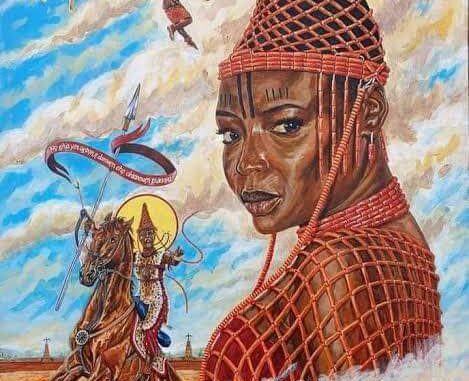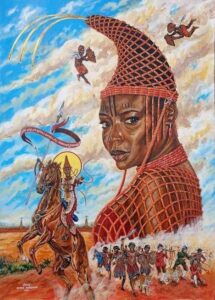

THE ORIGINAL PEOPLE AND FOUNDERS OF THE ẸDO
The original people and founders of the Ẹdo Empire and the Ẹdo people, initially were ruled by the Ogiso (Kings of the Sky) dynasty who called their land Igodomigodo. Igodo, the first Ogiso, wielded much influence and gained popularity as a good ruler. He died after a long reign and was succeeded by Ere, his eldest son.
In the 12th century, a great palace intrigue and battle for power erupted between the warrior crown prince Ekaladerhan, son of the last Ogiso and his young paternal uncle. In anger over an oracle, Prince Ekaladerhan left the royal court with his warriors. When his old father the Ogiso died, the Ogiso dynasty was ended as the people and royal kingmakers preferred their king’s son as natural next in line to rule.
The exiled Ekaladerhan, who was not known land, gained the title of Oni Ile-fe Izoduwa, which has been corrupted in the Yoruba language to Ọọni (Ọghẹnẹ) of Ile-Ifẹ Oduduwa. He refused to return to Ẹdo, but sent his son Ọranmiyan to become king in his place. Prince Ọranmiyan took up residence in the palace built for him at Usama by the elders, now a coronation shrine. Soon after he married a beautiful lady, Ẹrinmwide, daughter of Osa-nego, the ninth Enogie of Edọ. He and Erinwide had a son. After some years he called a meeting of the people and renounced his office, remarking that the country was a land of vexation, Ile-Ibinu, and that only a child born, trained and educated in the arts and mysteries of the land could reign over the people.
The country was afterward known by this name. He caused his son born to him by Ẹrinmwide to be made King in his place, and returned to Yoruba land Ile-Ife. After some years in Ife, he left for Ọyọ , where he also left a son behind upon leaving, and his son Ajaka ultimately became the first Alafin of Ọyọ of the present line, while Ọranmiyan (the exiled Prince Ekaladerhan, also known as Izoduwa) himself was reigning as Ọọni of Ifẹ. Therefore, Ọranmiyan of Ife, the father of Ẹwẹka I, the Ọba of Benin, was also the father of Ajaka, the first Alafin of Ọyọ. Ọọni of Ifẹ and Alafe of Ọyọ is a Bini spoken language all the Kings title in Southerner are Ẹdo Language. In Nigeria Ẹdo has the greatest and rich culture and most influence in West Africa and powerful King in Nigeria.
Allegedly Ọba Ẹwẹka later changed the name of the city of Ile-Binu, the capital of the Benin kingdom, to “Ubinu.” This name would be reinterpreted by the Portuguese as “Benin” in their own language. Around 1470, Ẹwuare changed the name of the state to Ẹdo.
This was about the time the people of Ọkpẹkpẹ migrated from Benin City. The Portuguese visited Benin City around 1485. Benin grew rich during the 16th and 17th centuries due to trade within southern Nigeria, as well as through trade with Europeans, mostly in pepper and ivory. In the early 16th century the Ọba sent an ambassador to Lisbon, and the King of Portugal sent Christian missionaries to Benin. Some residents of Benin could still speak a pidgin Portuguese in the late 19th century.
Many Portuguese loan words can still be found today in the languages of the area. Drawing of Benin City made by an English officer, 1897.
On 17 February 1897, Benin City fell to the British. In the “Punitive Expedition”, a 1,200-strong British force, under the command of Admiral Sir Harry Rawson, conquered and razed the city after all but two men from a previous British expeditionary force led by Acting Consul General Philips were killed.
Alan Boisragon, one of the survivors of the Benin Massacre, includes references to the practice of human sacrifice in the city in a firsthand account written in 1898 (one year after the Punitive Expedition).
James D. Graham notes that although “there is little doubt that human sacrifices were an integral part of the Benin state religion from very early days,” firsthand accounts regarding such acts often varied significantly, with some reporting them and others making no mention of them.
The “Benin Bronzes”, portrait figures, busts and groups created in iron, carved ivory, and especially in brass (conventionally called “bronze”), were taken from the city by the British and are currently displayed in various museums around the world.
Some of the bronzes were auctioned off to compensate for the expenses incurred during the invasion of the city. Most of these artifacts can be found today in British museums and other parts of the world. In recent years, various appeals have gone to the British government to return such artifacts. The most prominent of these artifacts was the famous Queen Idia mask used as a mascot during the Second Festival of Arts Culture (FESTAC ’77) held in Nigeria in 1977 now known as “Festac Mask”.
The capture of Benin paved the way for British military occupation and the merging of later regional British conquests into the Niger Coast Protectorate, the Protectorate of Southern Nigeria and finally, into the Colony and Protectorate of Nigeria. The British permitted the restoration of the Benin monarchy in 1914, but true political power still lay with the colonial administration of Nigeria.
Following Nigeria’s independence from British rule in 1960, Benin City became the capital of Mid-Western Region when the region was split from Western Region in June 1963; it remained the capital of the region when the region was renamed Bendel State in 1976, and became the state capital of Ẹdo State when Bendel was split into Delta and Edo states in 1991.
Thank you for finding time to read our today story and don’t forget to share for more stories.

Leave a Reply